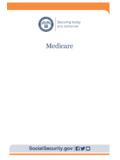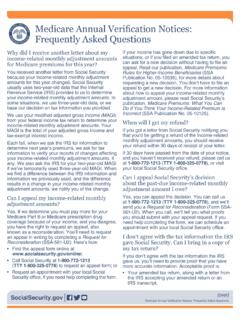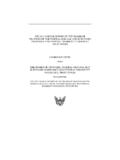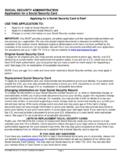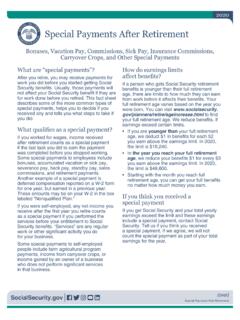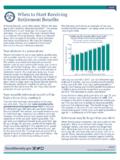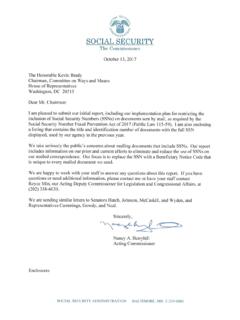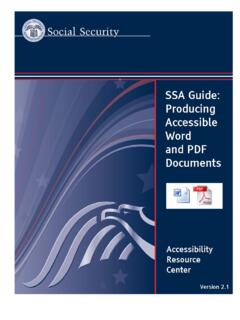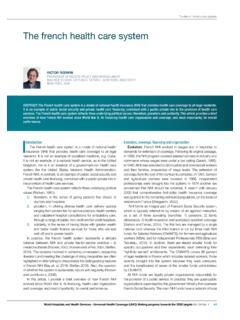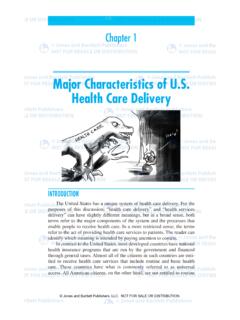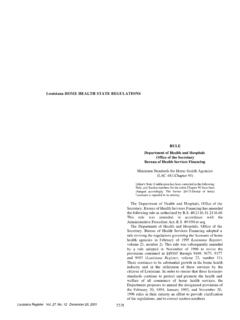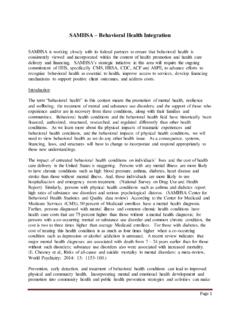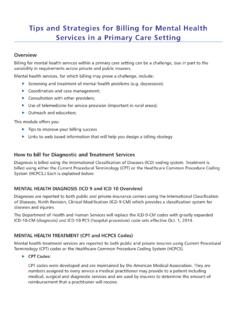Transcription of Health Care Early 1960s - Social Security Administration
1 My topic, Health care in the Early 1960s ,has a double set of meanings for me. I am ahistorian, and the 1960s are now "history,"ripe for new interpretations. Yet I was alsoan immigrant to the United States in 1961,fresh from working as an administrator inthe British National Health Service. Theperiod immediately before the Medicarelegislation in 1965 shines in my memorywith the vividness of new impressions:those of a young Health care student tryingto make sense of the U. S. Health care sys-tem, and indeed, of the United Health care system and the UnitedStates as a society stand, in many ways, asproxy for each other, now as then: Thewhole tells you much about the part, andthe part about the whole. In the early1960s, Health care was already a massiveenterprise.
2 By the late 1950s, hospitals em-ployed far more people than the steel in-dustry, the automobile industry, and of every eightAmericans was admitted annually as an in-patient (Somers and Somers, 1961). Tostudy Health care , with all its contradictionsand complexities, in the 1960s as in thepresent, is to explore the character and am-biguities of the United States itself, thatvast, brash, divided yet curiously the face of it, the United States was acountry blessed by plenty in the 1960s ,with hospitals and professionals that werethe envy of the world. Among the marvelsofmodernhospitalsthatprovokedRose mary A. Stevens is Professor of History and Sociology ofScience at the University of Pennsylvania. The opinions ex-pressed are those of the author and do not necessarily reflectthose of the University of Pennsylvania or the Health CareFinancing care in the Early 1960sRosemary A.
3 Stevens, care financing REVIEW/Winter1996/Volume 18, Number 2comment from a visiting delegation fromBritain in 1960 were complete air condi-tioning and artificial lighting systems, ad-justable electric beds, carpets in privaterooms, pass-through refrigerators in thekitchen, central milk kitchens, central ster-ile supply services, automatic X-ray proces-sors, autoanalyzers in the laboratory, plas-tic bags for blood, identification braceletsfor patients, pneumatic tube systems forcommunications and, not least, massivepower plants (Hurst, 1960). In the UnitedStates, the hospital was readily comparedwith industrial the gaps and variations in both rheto-ric and service were extraordinary. To thenew migrant, the vast cross-continentalnetwork of superhighways appeared toconnect cities-indeed swept through,around, or over them-without stopping torecognize their problems, character, or dif-ferences.
4 Similarly, in both the larger soci-ety and the smaller domain of Health serv-ices, there were searches for a unifyingcommon purpose, overlying conflicts andambiguities. Great leaders defined heroic,rallying causes: John F Kennedy, LyndonBaines Johnson, Martin Luther King, the structure and financing of thehealth system made little intuitive than 70 percent of the population hadsome form of hospital insurance by 1965(though less than one-half of the elderlypopulation did), 67 percent had surgical in-surance, and there was a growing marketfor major medical insurance ( Health Insur-ance Institute, 1980). But few were insuredfor primary or out-of-hospital care . Of themembers of the general population who re-ported they had "pains in the heart," 2511percent did not see a physician (Andersenand Anderson, 1967).
5 The elderly were particularly hard classic example of the proposed Medi- care beneficiary was the elderly school-teacher, blameless after a career of work. "Iam one of your old retired teachers thathas been forgotten," went one story in con-gressional hearings in 1959:Iam 80 years old and for 10 years Ihave been living on a bare nothing,two meals a day, one egg, a soup, be-cause I want to be of Scotch ancestry, my fatherfought in the Civil War to the end ofthe war, therefore, I have it in myblood to be independent and my dig-nity would not let me go down and beon I worked so hard that I have per-nicious anemia, $ for a little bottleof liquid for shots, wholesale, I couldn'tpay for it (Subcommittee on Problemsof the Aged and Aging of the Commit-tee of Labor and Public Welfare, 1959;Corning, 1969).
6 Members of the initial Medicare popula-tion, born in the late nineteenth century,had survived two world wars, a major eco-nomic depression, and enormous changesin the organization of work, mass produc-tion, rapid urbanization, and modern com-munications. As beneficiaries of the 1935 Social Security legislation, they were mem-bers of a culture of entitlement. By 1964, 83percent of the population 65 years of age orover were eligible for Social Security ben-efits; and there were almost three times asmany aged Social Security beneficiariesas there were 10 years earlier.' Yet beforeMedicare there were no entitlements'Not all those who were eligible for benefits received them; thecomparable figures were 63 percent in 1960 and 74 percent in1964 ( Department of Health , Education, and Welfare,1965).
7 12for the potentially catastrophic burdens ofhospital and doctors' programs were segmentedinto programs designed for apparently "de-serving" Americans, notably veterans andFederal employees, and for different cat-egories of the poor, State by State, whowere by definition "less deserving." Socialclass, like race, was a topic to which manyhealth practitioners had as yet given littlethought, although the topic had importantramifications, both for clinical practice andfor national politics. As one contemporarydoctor pointed out, "lower-class" patientswere often dissatisfied with their medicalcare and "many of them would prefer gov-ernment medicine" (Storrow, 1963). Theywere also, he wrote, easily angered, per-haps "physically aggressive when aroused,"expected frustration from those in author-ity,and tended to behave in unexpectedways.
8 But for the poor, the impersonalityand rudeness of large hospitals were oftendeterring factors in seeking care at all. Therift between doctor and patient was evi-dent,and nineteenth century attitudestoward poverty lingered among the moreaffluent in general. At least one-third of thepopulation said, when polled in 1963, thatan individual was personally responsiblefor his or her own poverty (Schiltz, 1970).By 1960 though, there were notable shiftstoward medical care for those of retire-ment age. Recognizing the special eco-nomic needs of the elderly, the Kerr-MillsAct of 1960 established a new category of"medical indigence" for beneficiaries ofFederal grants to the States for the for mental Health in 1963 tar-getedanotherpreviouslystigmatizedgro up-a major step toward de-institution-alizing the mentally ill.
9 The Health systemseemed full of exceptions, exclusions, andcontradictions,whilenationalleadersst ressedhigh-sounding,unifying care financing REVIEW/Winter1996/Volumeis,Number 2 JohnKenneth Galbraith (1958) hadcome up with one apparently unifying argu-ment when he labeled the United States"The Affluent Society." In theory, Ameri-cans were now all "middle-class consum-ers,"with standard expectations. Televi-sion, the new vehicle of mass culture,celebrated modern medicine as part of aculture of consumerism. All three of themajor television networks carried hospitaldramas in the Early 1960s , centeringAmericans in the fictional worlds of DoctorKildare (NBC), Ben Casey (ABC), and theNurses (CBS). The main issues for healthpolicy in this context were to define needygroups as middle-class and to ensure thatthey could behave like middle-class con-sumers by having the means to do so, thatis,by having adequate hospital insurancecoverage, backed up where necessary bypublic , as sociologist Michael Harrington(1962) demonstrated eloquently in his ownbest-seller in 1962, the highest mass stan-dard of living in the world was definitelynot shared by all.
10 There was "anotherAmerica": 40 to 50 million citizens whowere poor, who lacked adequate medicalcare, and who were "socially invisible" tothe majority of the population. Within thispoverty-stricken group were more than 8million of the 18 million Americans whowere 65 years of age and over, sufferingfrom a "downward spiral" of sickness although there were half amillion Americans in nursing homes, lessthan 60 percent of the homes were consid-ered acceptable (Harrington, 1962). Medi- care was formed in a society with idealisticexpectations of wealth for all-at least forall of those who "deserved" it yet increas-ingly isolated its minorities and its were evident rifts in American so-ciety in the Early 1960s , by race, age, class,and gender.
